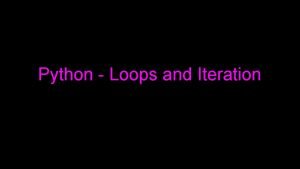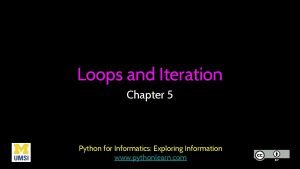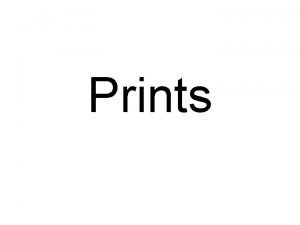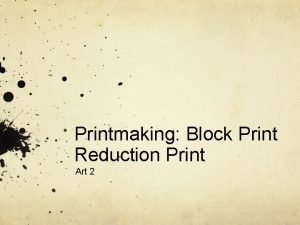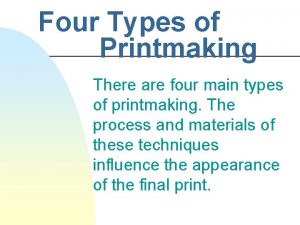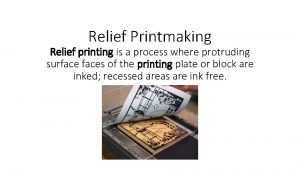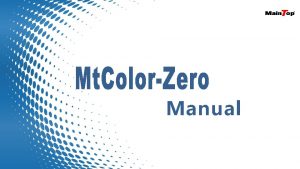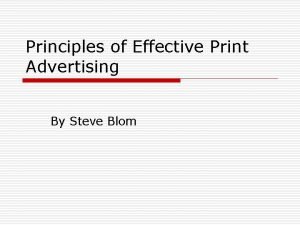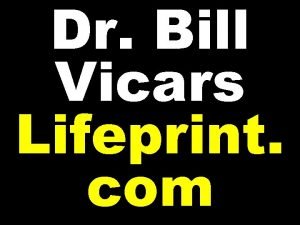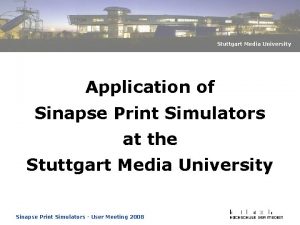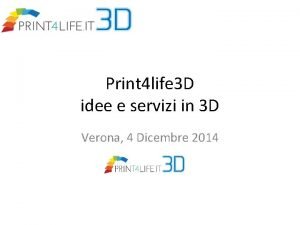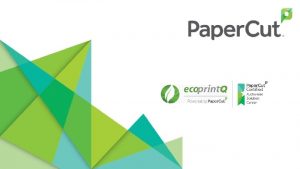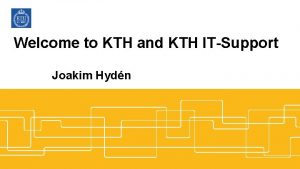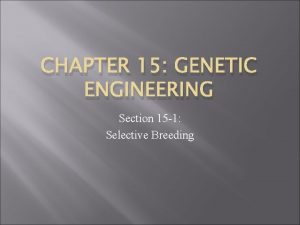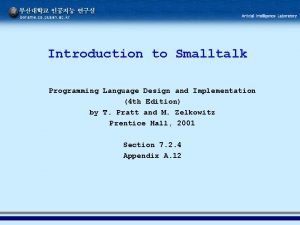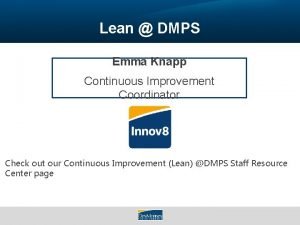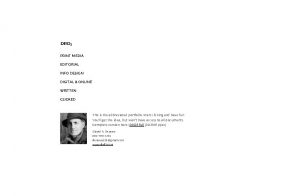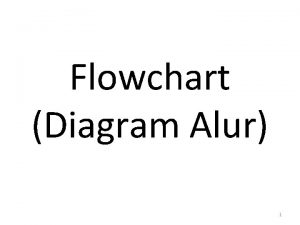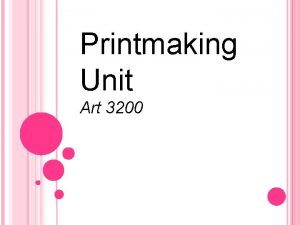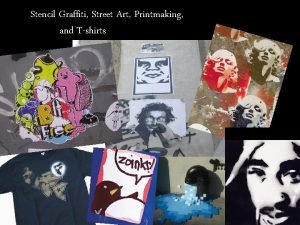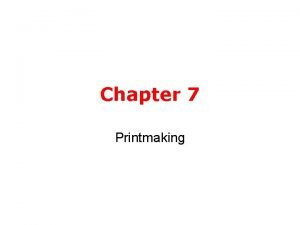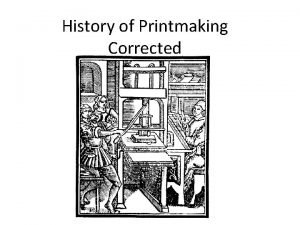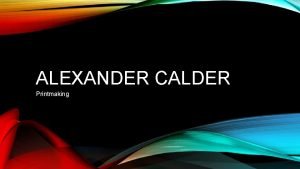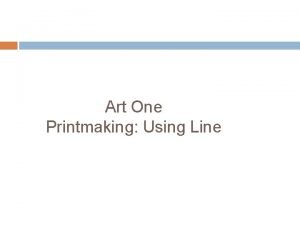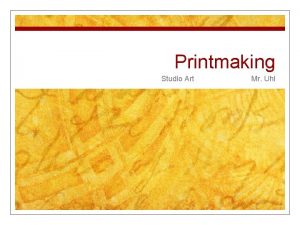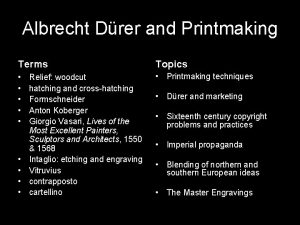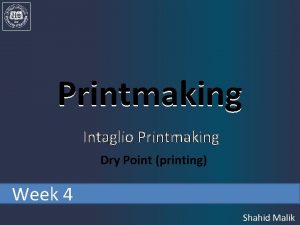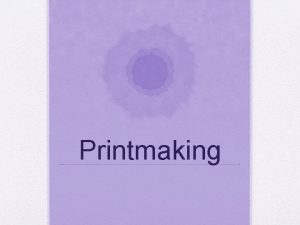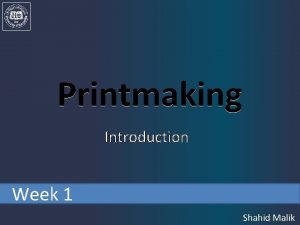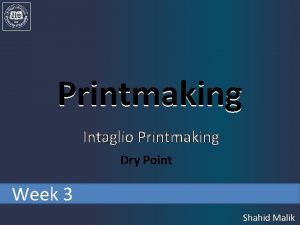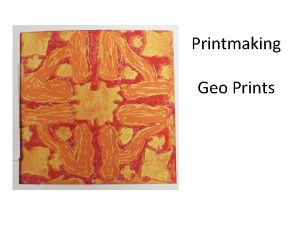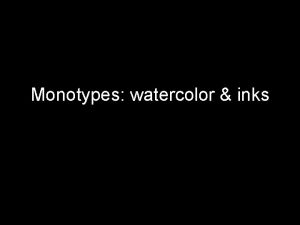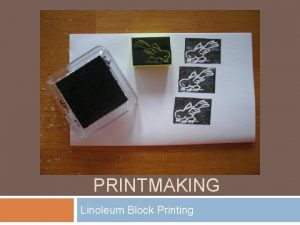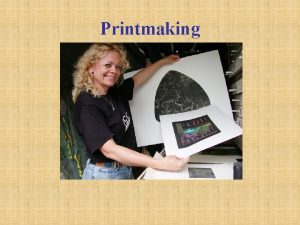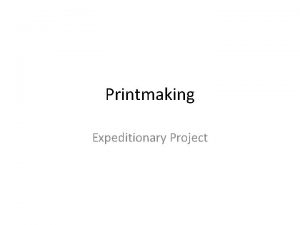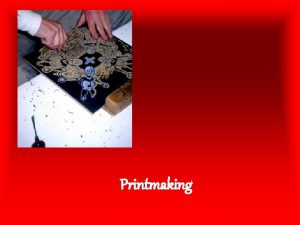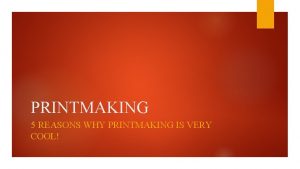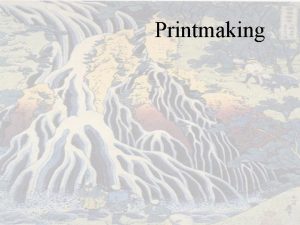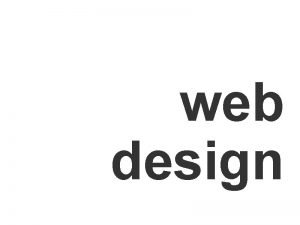PRINTMAKING Printmaking A print is a shape or






























- Slides: 30

PRINTMAKING

Printmaking A print is a shape or mark made from a block or plate or other object that is covered with wet color (usually ink) and then pressed onto a flat surface, such as paper or textile. Most prints can be produced over and over again by re-inking the printing block or plate. Printmaking can be done in many ways, including using an engraved block or stone, transfer paper, or a film negative.

Printmaking

Printmaking: intaglio - The collective term for several graphic processes in which prints are made from ink trapped in the grooves in an incised metal plate. Etchings and engravings are the most typical examples. Picasso

Printmaking: intaglio Piranase etching - An intaglio printing process in which an etching needle is used to draw into a wax ground applied over a metal plate. The plate is then submerged in a series of acid baths, each biting into the metal surface only where unprotected by the ground. The ground is removed, ink is forced into the etched depressions, the unetched surfaces wiped, and an impression is printed.

Printmaking: intaglio etching before Rembrandt etching after

Printmaking: intaglio aquatint - An intaglio, etching, and Goya tonal printing process in which a porous ground allows acid to penetrate to form a network of small dots in the plate. Aquatints often resemble wash drawings. Any pure whites are stopped out entirely before etching begins, then the palest tints are bitten and stopped out, and so on as in etching. This process is repeated 20 to 30 times until the darkest tones (deepest recesses in the plate) are reached.

Printmaking: intaglio Blake engraving - A method of cutting or incising a design into a material, usually metal, with a sharp tool called a graver. One of the intaglio methods of making prints, in engraving, a print can be made by inking such an incised (engraved) surface.

Printmaking: intaglio Engraving Durer (detail)

Printmaking: intaglio Engraving (detail)

Printmaking: intaglio Most contemporary commercial engraving is done in the production of currency, certificates, etc.

Printmaking: intaglio drypoint - An intaglio printing process in which burrs are left on the plate by the pointed needle (or "pencil") that directly inscribes lines. A kind of engraving which has a soft, fuzzy line because of the metal burrs. Whistler

Printmaking: intaglio Drypoint detail

Printmaking: intaglio Close mezzotint or mezzoprint - An engraving process that is tonal rather than linear. A copper or steel plate is first worked all over with a curved, serrated tool called a rocker, raising burrs over the surface to hold the ink and print as a soft dark tone. The design is then created in lighter tones by scraping out and burnishing areas of the roughened plate so that they hold less ink, or none in highlights. Details may be sharpened by engraving or etching in a "mixed mezzotint. "

Printmaking: relief woodcut - A print made by cutting a design in side-grain of a block of wood, also called a woodblock print. The ink is transferred from the raised surfaces to paper. Durer

Printmaking: relief linoleum cut, linocut, or lino-cut - A linoleum block or plate used for making relief prints. The linoleum can be cut in much the same way woodcuts are produced, however its surface is softer and without Lichtenstein grain.

Printmaking: relief Durer wood engraving - A print similar to a woodcut (woodblock print) in that it is made by cutting (engraving) a design into a block of wood, usually boxwood. However unlike a woodcut, the artist cuts the design on the endgrain of hardwood rather than the side grain of soft wood. The print's design can therefore be more intricate than the typical woodcut.

Printmaking: relief wood engraving block s & burin The gravers or burins used to work the block are similar to those used to engrave a copper or steel plate, but instead of producing lines that will print, they are used to produce non-printing lines. It is the uncut surface that takes the ink and prints.

Printmaking: relief Wood engraving Barry Moser detail

Printmaking: lithography Benton lithography - a method of printing from a prepared flat stone or metal or plastic plate. A drawing is made on the stone or plate with a greasy crayon or tusche, and then washed with water. When ink is applied it sticks to the greasy drawing but is resisted by the wet surface allowing a print — a lithograph — to be made of the drawing. The printmaker then covers the plate with a sheet of paper and runs both through a press under light pressure.

Printmaking: lithography Offset lithography is a printing technique which is widely used around the world. Most books, newspapers, and magazines are printed using offset lithography, and this printing technique is widely regarded as the workhorse of printing, because it is fast, efficient, cheap, and relatively easy. The “offset” in the name refers to the fact that the ink is transferred to a separate surface before being applied to the paper.

Printmaking: serigraphy Warhol serigraphy - A stencil method of printmaking in which an image is imposed on a screen of silk or other fine mesh, with blank areas coated with an impermeable substance, and ink is forced through the mesh onto the printing surface. Also called silkscreen process and screenprinting. A serigraph is a print made by this method.

Printmaking: serigraphy Screenprinting is more versatile than traditional printing techniques. The surface does not have to be printed under pressure, unlike etching or lithography, and it does not have to be planar. Screenprinting inks can be used to work with a variety of materials, such as textiles, ceramics, wood, paper, glass, metal, and plastic.

Printmaking: serigraphy Screenprinting is used in many different industries, including: Clothing Textile fabric Product labels Printed electronics, including circuit board printing Balloons Medical devices Skateboard graphics Signs and displays

Printmaking: monoprint monotype - A one-of-a-kind print made by painting on a smooth metal, glass or stone plate and then printing on paper. The pressure of printing creates a texture not possible when painting directly on paper. Degas

Printmaking: non-toxic Friedhard Kiekeben Non-toxic printmaking is a concept or trade description covering a range of health and environmentally friendly working methods including: acrylic resist, intaglio-type, solar plate, and waterless lithography.

Printmaking: intaglio-type Keith Howard introduced the term Intaglio-Type to describe a broad range of non-etch intaglio techniques that do not require the toxic chemicals associated with traditional etching. Intaglio-Type relies on a photopolymer (i. e. , light sensitive film) laminated to a flat plate, exposed to ultraviolet light through a stencil and developed in a mild solution of soft water. Ink is held differentially by the developed film and the image transfers in reverse onto paper under the pressure of the press. Plates are easily and quickly re-worked

Printmaking: intaglio-type traditional intaglio non-toxic intaglio-type ink paper incision plate polymer film plate paper incision

Printmaking: solarplate Solarplate printing or etching is less toxic than traditional etching and a versatile medium. The artist creates a piece of artwork on a transparent film which is overlaid on a solarplate and exposed, both the film and plate together, in the sun.

Printmaking: solarplate “The UV light effectively transfers a drawn image to the plate and the plate can be used to print either in relief or intaglio. "
 Iteration.n5 how many panels
Iteration.n5 how many panels Iteratio.n5
Iteratio.n5 Shape matching and object recognition using shape contexts
Shape matching and object recognition using shape contexts Bolongie
Bolongie Aerodynamic shapes
Aerodynamic shapes Matrix in printmaking
Matrix in printmaking Printmaking tools
Printmaking tools Types of printmaking
Types of printmaking Relief printing is
Relief printing is Maintop color management
Maintop color management How to print disneyland tickets
How to print disneyland tickets Principles of print advertising
Principles of print advertising Life print.com
Life print.com What is a type line in fingerprint
What is a type line in fingerprint Sinapse print simulator
Sinapse print simulator Print 4 life
Print 4 life Conclusion of advertising media
Conclusion of advertising media Papercut job tickerting print software
Papercut job tickerting print software Digital foil enhancement
Digital foil enhancement Which hidden formatting symbol represents a space character
Which hidden formatting symbol represents a space character Kth print
Kth print Grepglobal.com
Grepglobal.com Difference between hypertext and hypermedia
Difference between hypertext and hypermedia Dna finger print
Dna finger print Smalltalk designed by
Smalltalk designed by Dmps print shop
Dmps print shop Ds print cambridge
Ds print cambridge Drd xx
Drd xx Flowchart symbols bahasa indonesia
Flowchart symbols bahasa indonesia Compound treasure
Compound treasure What are the features to analyze on shoe print evidence?
What are the features to analyze on shoe print evidence?
